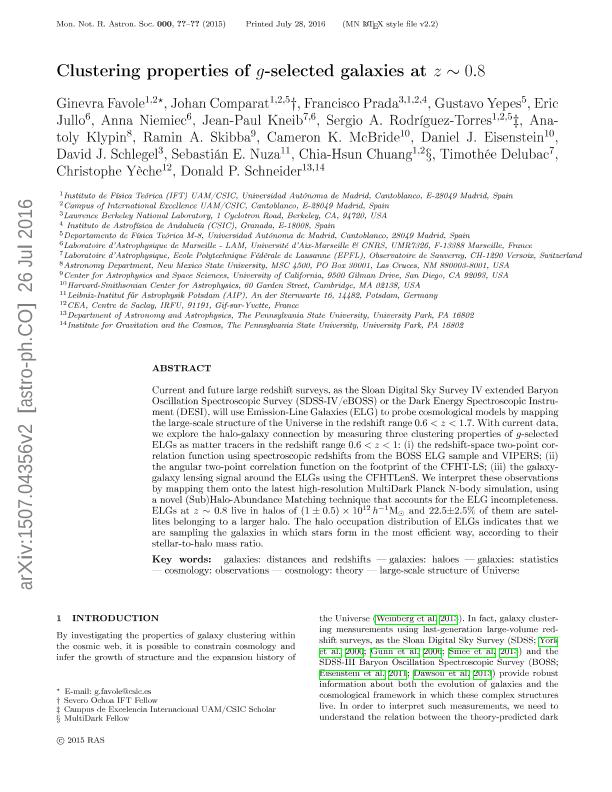Mostrar el registro sencillo del ítem
dc.contributor.author
Favole, Ginevra
dc.contributor.author
Comparat, Johan
dc.contributor.author
Prada, Francisco

dc.contributor.author
Yepes, Gustavo
dc.contributor.author
Jullo, Eric
dc.contributor.author
Niemiec, Anna
dc.contributor.author
Kneib, Jean-Paul
dc.contributor.author
Rodriguez Torres, Sergio A.

dc.contributor.author
Klypin, Anatoly
dc.contributor.author
Skibba, Ramin A.
dc.contributor.author
McBride, Cameron K.
dc.contributor.author
Eisenstein, Daniel J.

dc.contributor.author
Schlegel, David J.

dc.contributor.author
Nuza, Sebastian Ernesto

dc.contributor.author
Chuang, Chia-Hsun
dc.contributor.author
Delubac, Timotheé
dc.contributor.author
Yèche, Christophe
dc.contributor.author
Schneider, Donald P.
dc.contributor.author
Schneider, Donald P.

dc.date.available
2019-05-22T17:32:47Z
dc.date.issued
2016-10
dc.identifier.citation
Favole, Ginevra; Comparat, Johan; Prada, Francisco; Yepes, Gustavo; Jullo, Eric; et al.; Clustering properties of g-selected galaxies at z ~ 0.8; Wiley Blackwell Publishing, Inc; Monthly Notices of the Royal Astronomical Society; 461; 4; 10-2016; 3421-3431
dc.identifier.issn
0035-8711
dc.identifier.uri
http://hdl.handle.net/11336/76871
dc.description.abstract
Current and future large redshift surveys, as the Sloan Digital Sky Survey IV extended Baryon Oscillation Spectroscopic Survey (SDSS-IV/eBOSS) or the Dark Energy Spectroscopic Instrument (DESI), will use emission-line galaxies (ELGs) to probe cosmological models by mapping the large-scale structure of the Universe in the redshift range 0.6 < z < 1.7. With current data, we explore the halo-galaxy connection by measuring three clustering properties of g-selected ELGs as matter tracers in the redshift range 0.6 < z < 1: (i) the redshift-space two-point correlation function using spectroscopic redshifts from the BOSS ELG sample and VIPERS; (ii) the angular two-point correlation function on the footprint of the CFHT-LS; (iii) the galaxy-galaxy lensing signal around the ELGs using the CFHTLenS. We interpret these observations by mapping them on to the latest high-resolution MultiDark Planck N-body simulation, using a novel (Sub)Halo-Abundance Matching technique that accounts for the ELG incompleteness. ELGs at z ~ 0.8 live in haloes of (1 ± 0.5) × 10 12 h -1 M⊙ and 22.5 ± 2.5 per cent of them are satellites belonging to a larger halo. The halo occupation distribution of ELGs indicates that we are sampling the galaxies in which stars form in the most efficient way, according to their stellar-to-halo mass ratio.
dc.format
application/pdf
dc.language.iso
eng
dc.publisher
Wiley Blackwell Publishing, Inc

dc.rights
info:eu-repo/semantics/openAccess
dc.rights.uri
https://creativecommons.org/licenses/by-nc-sa/2.5/ar/
dc.subject
Cosmology: Observations - Cosmology
dc.subject
Galaxies: Distances And Redshifts
dc.subject
Galaxies: Haloes
dc.subject
Galaxies: Statistics
dc.subject
Theory - Large-Scale Structure of Universe
dc.subject.classification
Astronomía

dc.subject.classification
Ciencias Físicas

dc.subject.classification
CIENCIAS NATURALES Y EXACTAS

dc.title
Clustering properties of g-selected galaxies at z ~ 0.8
dc.type
info:eu-repo/semantics/article
dc.type
info:ar-repo/semantics/artículo
dc.type
info:eu-repo/semantics/publishedVersion
dc.date.updated
2019-05-14T21:37:17Z
dc.journal.volume
461
dc.journal.number
4
dc.journal.pagination
3421-3431
dc.journal.pais
Reino Unido

dc.journal.ciudad
Londres
dc.description.fil
Fil: Favole, Ginevra. Instituto de Fisica Teorica de Madrid; España
dc.description.fil
Fil: Comparat, Johan. Universidad Autónoma de Madrid; España
dc.description.fil
Fil: Prada, Francisco. Lawrence Berkeley National Laboratory; Estados Unidos. Universidad Autónoma de Madrid; España
dc.description.fil
Fil: Yepes, Gustavo. Universidad Autónoma de Madrid; España
dc.description.fil
Fil: Jullo, Eric. Laboratoire D'astrophysique de Marseille; Francia
dc.description.fil
Fil: Niemiec, Anna. Laboratoire D'astrophysique de Marseille; Francia
dc.description.fil
Fil: Kneib, Jean-Paul. Laboratoire D'astrophysique de Marseille; Francia
dc.description.fil
Fil: Rodriguez Torres, Sergio A.. Universidad Autónoma de Madrid; España
dc.description.fil
Fil: Klypin, Anatoly. New Mexico State University Las Cruces; México
dc.description.fil
Fil: Skibba, Ramin A.. University of California at San Diego; Estados Unidos
dc.description.fil
Fil: McBride, Cameron K.. Harvard-Smithsonian Center for Astrophysics; Estados Unidos
dc.description.fil
Fil: Eisenstein, Daniel J.. Harvard-Smithsonian Center for Astrophysics; Estados Unidos
dc.description.fil
Fil: Schlegel, David J.. Lawrence Berkeley National Laboratory; Estados Unidos
dc.description.fil
Fil: Nuza, Sebastian Ernesto. Consejo Nacional de Investigaciónes Científicas y Técnicas. Oficina de Coordinación Administrativa Ciudad Universitaria. Instituto de Astronomía y Física del Espacio. - Universidad de Buenos Aires. Facultad de Ciencias Exactas y Naturales. Instituto de Astronomía y Física del Espacio; Argentina
dc.description.fil
Fil: Chuang, Chia-Hsun. Universidad Autónoma de Madrid; España
dc.description.fil
Fil: Delubac, Timotheé. Swiss Federal Institute Of Technology Epfl, Lausanne; Suiza
dc.description.fil
Fil: Yèche, Christophe. Commissariat A L'energie Atomique. Institut de Recherche Des Lois Fondamentales de L'univers; Francia
dc.description.fil
Fil: Schneider, Donald P.. Pennsylvania State University;
dc.description.fil
Fil: Schneider, Donald P.. State University of Pennsylvania; Estados Unidos
dc.journal.title
Monthly Notices of the Royal Astronomical Society

dc.relation.alternativeid
info:eu-repo/semantics/altIdentifier/doi/http://dx.doi.org/10.1093/mnras/stw1483
Archivos asociados
